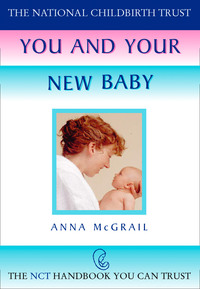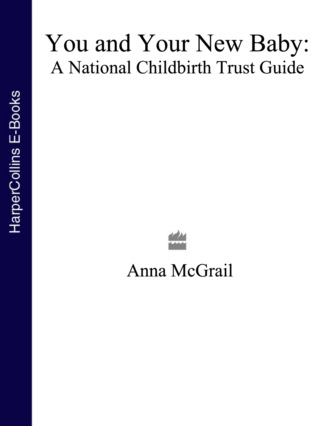
Полная версия
You and Your New Baby
Research continues into the causes and the reasons why some women get this rare and distressing illness, and the most effective treatments, but there are no definite answers yet. The work done by Dr Katarina Dalton on the use of progesterone injections as a means of prevention is gaining coverage and acceptance. Although its preventive role cannot help a first-time sufferer, it can be of great reassurance to those who have suffered that they do not need to go through this again.
A ‘ROUTINE’
CHANCES ARE, at least one health professional or relative will have advised you how desirable a routine is for your baby, although very young babies may not respond well to being ‘put into’ a routine. However, it can be helpful to establish an evening routine of supper, bath, story, bed (or similar). This sort of routine, if established early, can reduce bedtime problems in toddlerhood. Indeed, it gives most children a feeling of safety and security if roughly the same things happen at roughly the same time every day. It helps to give a sense of pattern and reassurance. And it can help you, too, if you’re finding the demands of parenthood overwhelming: a routine can bring everything down to more manageable proportions.
Beverley felt she needed to get her new life into some sort of order: ‘I think my idea of a “routine” came from my mum. Also, it came from me in the first three months trying not to have a routine. I remember thinking, “I want Josh to be a really flexible baby. I’m going to take him out with me whenever I need to go, feed him whenever he’s hungry, put him to sleep when he’s tired, and he’s just going to adapt and be really flexible and it’ll be great.” And it was a nightmare. He ended up not having a sleep in the day, and then he wasn’t sleeping well at night… it was just terrible. And I found that once I started doing things in this very strict routine – which I really resented, I didn’t like having to do it at all – things got better. I thought, “Right, ten o’clock, he’ll have a morning nap. Three o’clock, he’ll have an afternoon nap,” and I put him in his cot and he just started having them. It made a difference because I could say to people, “Oh, come round then because I know he’ll be asleep”, or whatever. I know where I stand, now.’
YET, NO MATTER how desirable a ‘routine’ may be, one thing many parents resent is the lack of spontaneity in their lives. Whether you intended to carry on as before or not, you’ll soon find you can’t.
Deirdre’s mental planning will sound familiar to you if you’ve already had your baby: ‘I’d think, right, she’s due for a feed in the next hour or so, and afterwards she’ll probably fill her nappy, so if I change her then, we could go out after that and she’ll probably have a sleep in the pram, but that means I won’t have had my lunch … Okay, if I have my lunch now – it’s about ten o’clock in the morning – that might do it. And if we spend longer there than I planned on, I’ll be in trouble if I don’t have what she needs, so I’ll have to take wipes, nappy cream, dummy, bottle of water … And then I have to organise all these and then she wakes up and I still haven’t had my lunch and this is all just to go round and have a cup of tea with a friend. How women go out to work every morning when they have babies, I just don’t know. This is what I can’t stand, not just being able to pop out and have a cup of tea when I feel like it.’
Olivia’s comments ring true too: ‘There’s a picture in a book of a father typing and this baby sitting in a bouncy chair watching him. It’s got this cheerful caption like “Let the baby join in family life!” I can just see Beatrice sitting in her chair watching while Robert studies engineering. I think images like that can build up a false picture. Especially if your baby’s not conforming to that image.’
WHEN YOUR BABY arrives, images are what you have to forget. In the mother-and-baby magazines, those are models you are looking at, with their shiny hair and their designer outfits in their polished kitchens. They aren’t real mums. Real mums have mysterious stains on their jumpers and a permanently quizzical expression, as if they’ve just forgotten which day of the week it is … which is usually because they have. And real mums have real babies.
Coping with that reality, with all its stresses and strains as well as its joys and delights, is what becoming a family is all about.

CHAPTER two Learning new skills
ONCE YOU’RE home, it often feels like people are relying on you to be the expert:
‘How is he sleeping? Good or bad?’ What’s ‘good’? What’s ‘bad’?
‘Are her feeds regular?’ What’s ‘regular’?
‘Are his nappies normal?’ How can a nappy be normal? Should I be saving it to show them, perhaps? Then they could decide whether it was normal or not.
People look on you as the expert because already, even when your baby is very tiny, no one knows him or her as well as you do. You may feel you have an impossible amount to learn, but don’t forget you have instincts, too, and these are for listening to, not ignoring.
Whatever is right for you, your partner and your baby, if it makes you all happy, then you’re being exactly the kind of parents your baby needs you to be.
HOLDING
SOME PARENTS find it hard to get used to handling their new babies, feeling they’re very fragile, others find it hard to put them down.
You will notice that your baby will respond much more cheerfully if you keep him held close to you and don’t lurch him from one position to another very suddenly. It’s an instinctive reaction in most of us to stroke and cuddle our babies, but keep it gentle. Save games when you hurl him madly through the air for later on in life. If it’s a toddler saying: ‘Throw me up to the sky, Daddy’, you can join in the fun. But shaking or throwing a small baby is never fun. The baby will hate it and you could seriously harm him.
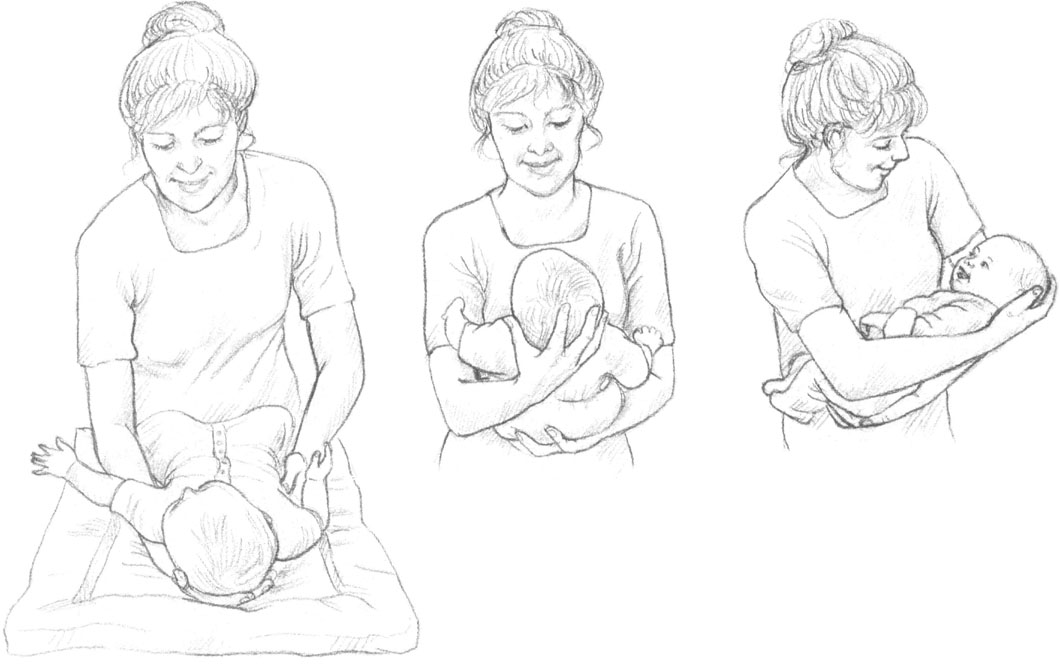
Ways to pick up and hold your baby.
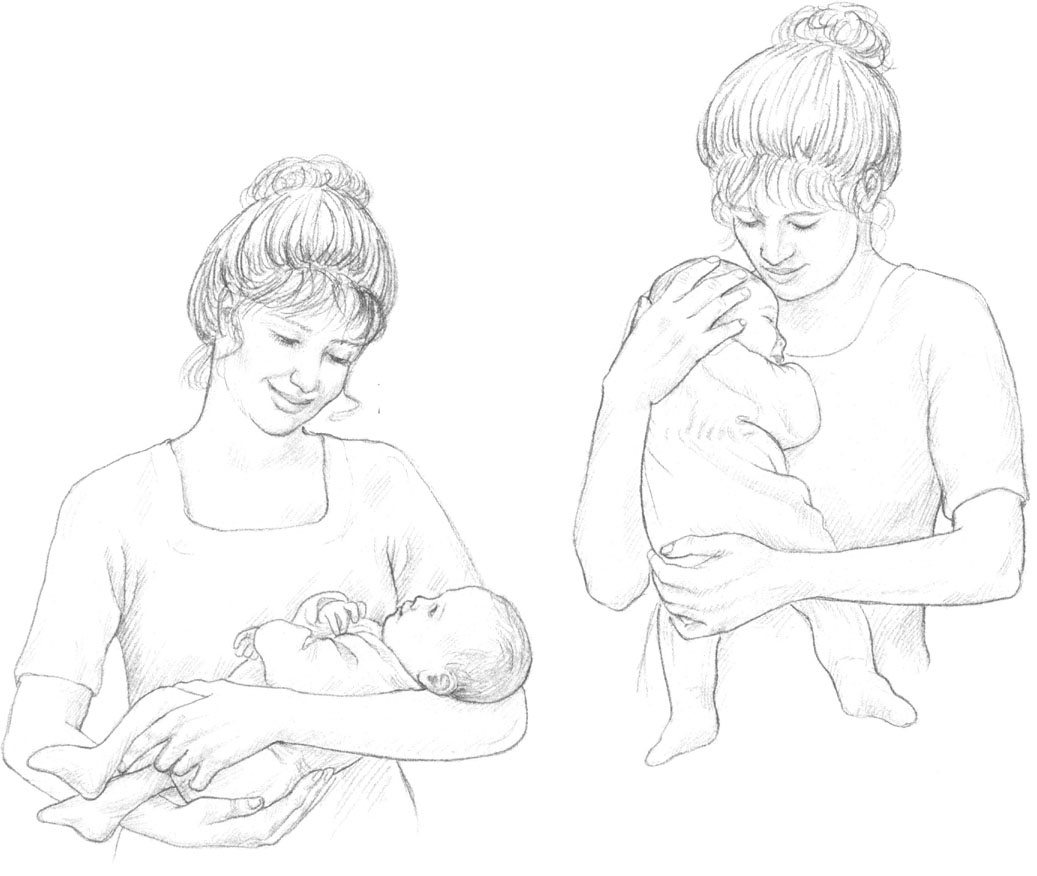
Remember to support his heavy head.
Baby massage
AS AN EXTENSION of the stroking and cuddling that new parents find babies love, you might like to try baby massage as a way of soothing and relaxing your baby. A massage with a bath can be very beneficial – both for parent and baby, establishing a bond between them and allowing loving non-verbal communication.
If you’re interested, you might find ads for baby massage courses in your local NCT newsletter or GP practice, as these will enable you to find out more about the techniques involved and the most soothing oils to use. Or try an introductory video as a guide.
BABIES LIKE TO BE HELD
Close to you
With their head and neck supported
Upright, looking over your shoulder
Cradled in your arms – perfect for talking
In a baby carrier or sling
Gently but firmly
With your arm around his tummy and his back against your body – it widens his horizons
A lot.
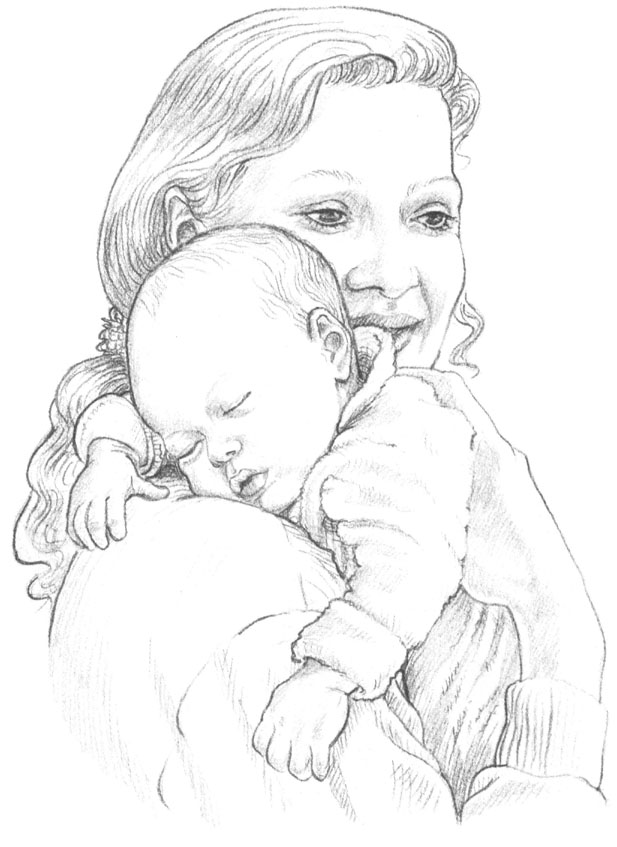
STEP BY STEP TO BATHING YOUR BABY
A calm, warm environment is essential. Choose a time when you will not have to rush, when you aren’t likely to be interrupted, and where you can get on with things in your own way and in your own time.
Make sure it’s the right time for your baby, too; that she has been fed so she isn’t screaming with hunger, and definitely do not try a bath when your baby would much rather be having a nap: she’ll scream with tiredness throughout, you’ll both end up exhausted and your baby will probably be sick in the bath-water, she’s so cross.
Baths are meant to be enjoyable for all concerned. If your baby hates them, you can probably get away with topping and tailing for a week. If your baby loves them, you can give her one every day.
Have everything ready beforehand:
- warm dry towel
- a spare warm, dry towel
- sponge
- baby shampoo If you like
- a jug containing warm water to rinse your baby’s head – don’t use the bath-water to do this – it could leave shampoo residue on your baby’s scalp and this can cause irritation.
You’ll need a small baby bath. Prepare this beforehand, too, so that everything’s ready when you undress your baby – make sure the water’s not too hot. After a couple of months, when your baby’s neck Is stronger and she’ll enjoy it more, you may like to take her in the bath with you. If you do this, have someone on stand-by to lift her out. Don’t attempt to manoeuvre her and yourself out simultaneously with both of you wet and one of you wriggly. Again, the temperature of the water should suit the baby, not you.
Most babies hate getting their heads wet, so the hair-washing part of the bath should be done as quickly as possible. If she starts to scream as soon as she feels the first drop on her scalp, don’t persevere; just quickly wipe over her head with the dampened sponge and try again another day.
BATHING
YOUR NEWBORN will seem so fragile, you might well feel nervous handling her at first. Her head might be an odd shape if it has been moulded as she passed down the birth canal (for more information on this and other physical features of your newborn, see Chapter One) and you may be worried about touching the fontanelles. Nevertheless, you can’t let this stop you washing her – you’ll have to get round to this eventually and in many ways, once you’re over the immediate aftermath of the birth, the sooner you do it the better it is for you and your baby. It will make her feel more comfortable if you can gently wash away any blood or dried fluids remaining after labour; and a successfully washed infant, all fluffy and warm, will boost your confidence as a parent no end.
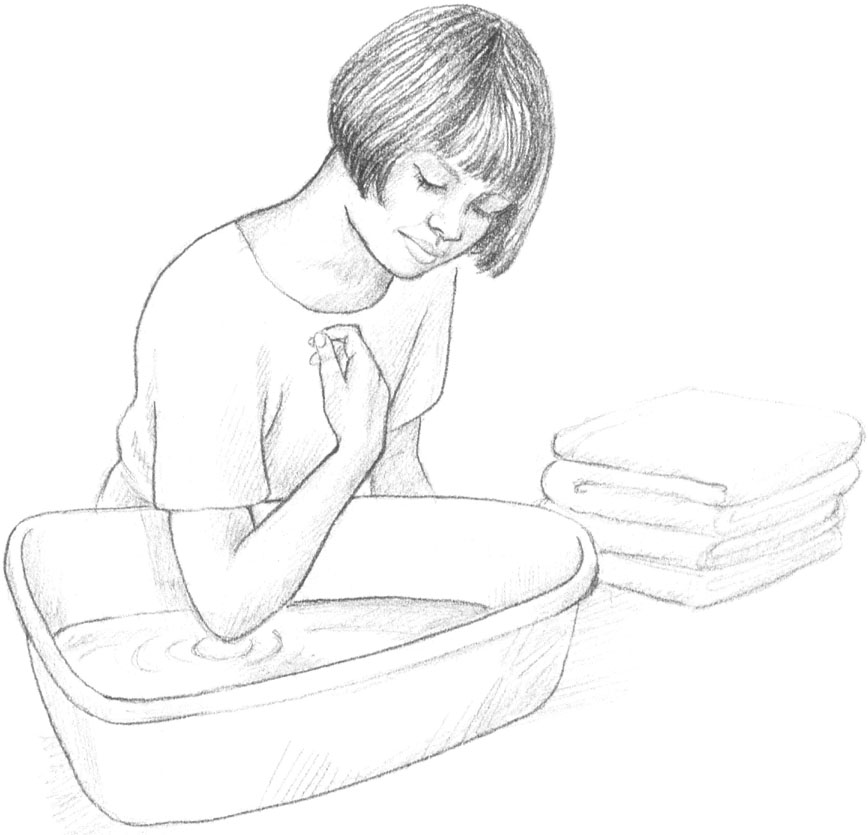
Your hand isn’t always an accurate gauge of temperature. Your elbow is much more reliable.
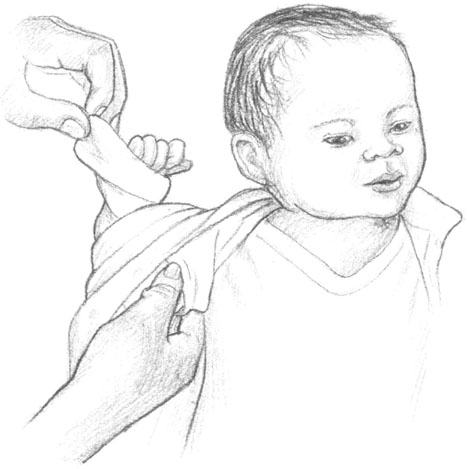
Undress your baby in a warm room. Talking to her while you undress her can reassure you both.

Wrap your baby in her towel and gently wipe her eyes from corner outwards, and clean the rest of her face – all with damp cotton wool.

Then wash your baby’s hair while she is still wrapped in the towel.
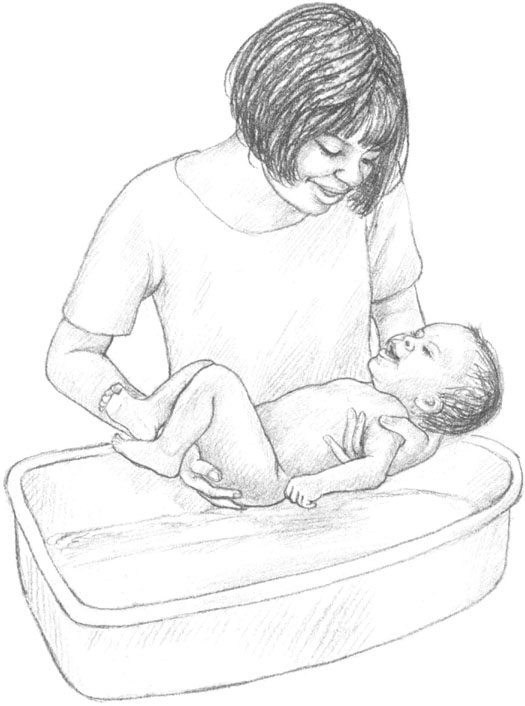
Hold your baby securely If you are confident, she will be, too.
You don’t have to jump in with both feet straight away and embark on a fully-fledged bathtime, unless this is what you want. You can just ‘top and tail’ her – i.e. clean only the bits that really need it. Ask your midwife or one of the nursing staff to show you how, and this will keep the baby happy and comfortable.
Washing your baby’s hair
1 Undress your baby and wrap her in a towel, folded over at the back so you can easily cover her head with it afterwards.
2 Hold your baby firmly but gently. Hold her under one arm with her body against yours and her head over the water. Support her head with the hand of that arm. Tip your baby downwards slightly so that the water won’t run into her eyes.
3 Use your other hand to wet her hair with a sponge.Let her enjoy the warm water and freedom to splash.Don’t leave her in the water for too long. End the hath while you are both still enjoying it and you’ll both look forward to the next one.
4 Rub in the shampoo gently then wash it off again.
5 Rinse with clear water left ready nearby.
6 Pat her head dry and wrap her warmly in the towel.
7 If you want to brush her hair, use a very soft-bristled brush.
Cradlecap
WHEN SHE IS between about a month and six months old, you may notice, underneath your baby’s hair, a yellowish crust on her scalp. This is cradlecap, a condition so common almost every baby has it. It does your baby absolutely no harm whatsoever and, left to its own devices, will disappear completely as your baby grows. That said, if it is very thick or very noticeable, you will probably find yourself wishing you could do something about it. If so, don’t be tempted into picking or trying to brush it off – you could pull the baby’s hair out or cause an infection.
Some suggested remedies are:
Massaging a tablespoon of almond oil or olive oil into your baby’s scalp, leaving it for an hour then shampooing and rinsing thoroughly. You’ll have to endure your baby smelling like a salad though
(If you adopt this approach, you will have to keep the oil away from your baby’s eyes while you’re applying it, and make sure her fingers don’t touch the oil, as she may then get it in her eyes.)
Trying a bicarbonate of soda rinse: dissolve a teaspoonful in 500ml of warm water and dab it on with a cotton wool pad. Shampoo and rinse thoroughly. You will need to do this once or twice a week
Combing her hair gently little and often – this will help to loosen the flakes.
No matter which recipe you try, cradlecap won’t disappear overnight, but it will disappear.
Other things to check for:
IF YOU NOTICE patches of redness or soreness on your baby’s neck or behind her ears, then it may be eczema; ask your health visitor for advice.
CHANGING
WHAT’S IT TO be? Terries or ‘disposables’? Perhaps more importantly, who’s going to do it? Especially when it’s the middle of the night, your baby has completed an extraordinary performance, and it’s a repeat show of the one she did two hours ago.
Nappy changing is one of the skills you will become surprisingly adept at over the next couple of years.
Disposables
Advantages
Undoubtedly easier in general. This is why they are so popular.
They are very absorbent and can see a baby through the night without you having to face a cotful of wet bedding every morning.
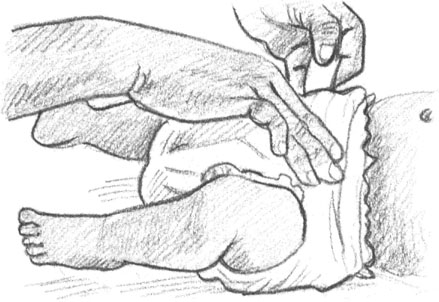
Remove old nappy on a waterproof surface. Accidents will happen.

Clean your baby thoroughly with warm water. Allow him to dry in the air if possible.

Barrier cream can help prevent nappy rash.
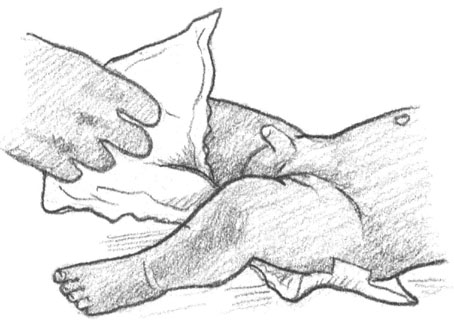
Lift your baby’s bottom up, put the nappy underneath and then pull the nappy through to the front.

Vests with poppers that fasten underneath can do wonders for keeping lop-sided nappies in place.
Disadvantages
You may have trouble finding some that suit your baby. Every baby has a unique shape and yours may not fit into one of the standard ‘nappy sizes’, so that you’re always running the risk of leaks or pulling the adhesive tapes so tight your baby can scarcely breathe
If you get cream on the tape, the tape loses its stickiness. This tends to happen at awkward moments
Cost. Although the pence-per-nappy price might not be exorbitant, the amount that you will pay out in total over the years your baby is using nappies is stunning
They are not earth-friendly; the raw materials they require, the processes used in their production, and the fact that they are not truly easy to ‘dispose’ of except in landfill sites, which are rapidly filling up, are not easy issues for new parents to ignore, if they are keen to preserve the planet for the next generation.
IF YOU ARE A committed disposable-user, you may find the new nappy-delivery services a great boon, especially in the early days when it’s more difficult to get out with your baby, you’re getting through the nappies at a great rate, and they are a very bulky item to carry home. Some shops will bring a month’s worth, with no charge for delivery, direct to your door.
Terries
Advantages
They are environmentally friendly
They are comfortable, soft, and have no hard edges to irritate babies’ skin
Cheaper in the long run (see old editions of Which? in your library for comprehensive studies on this topic)
Easier these days so long as you have a washing machine and preferably a tumble dryer.
Disadvantages
Learning the origami necessary for successful nappy adherence
Safety pins
Soaking
Buckets (smell)
Washing
Guilt – although the washing and drying of reusable nappies demands only a fraction of the energy used by disposables, the chlorine, bleach and washing powder may help to destroy the ozone layer.
AVOIDING NAPPY RASH
Change your baby’s nappy frequently
Clean and dry your baby’s bottom and all the creases thoroughly
Allow your baby some nappy-free kicking time on the mat at as many changes as you can manage
Use a barrier cream to help prevent the skin getting too damp
At the first sign of redness, change nappies even more frequently
Witch hazel and camomile creams are both helpful if a rash does develop. There is a variety available and you may like to try one or two before finding one that suits
The best cure is letting your baby kick naked on a blanket on a waterproof mat for as long as he likes
Severe nappy rash may be caused by thrush which needs suitable treatment. Consult your doctor or health visitor; if you are breastfeeding, you may need treatment too.
ALSO (FORGET the stories of women taking their nappies down to the river – that wasn’t in North London), you have to have a washing machine these days to be a sane terry-user.
There are now many cotton-nappy delivery and laundry services around. These involve ‘fitted’ nappies that don’t require major folding techniques. You order up the correct size nappies for your baby – from newborn to toddler – which are then delivered to your door. You also get a bin with a liner, in which you place the used nappies until they are collected by the service, who simultaneously provide you with clean nappies. The laundered nappies are thermo-sterilised before being reused, so not only do you not have to wash them yourself, you can feel virtuous about not making any contribution to the landfill sites.
Or you could use terries to start with, disposables on holiday and cotton nappies later. The permutations are endless. Whatever you choose, make sure you’re happy – those first few weeks can seem like nothing more than an endless round of nappy changing and feeding at times, so make it as easy and enjoyable as you can.
DRESSING
IF YOU HAVE infinite leisure and infinite ready cash, you can go round the shops ticking off those suggested ‘layette’ lists: three nightdresses, four vests… but you’ll find that the baby can get through three nightdresses in one morning. And what sort of vest do you want? What sort of sleepsuit is best? Front opening? Back opening? Poppers down each leg or not?
If you’re at all sensible, you will borrow twice as many newborn-size clothes as you think could possibly need. Babies are newborn-size for such a short time, the clothes hardly have a chance to get worn, never mind worn out, though some of them can develop rather startling stains. Also, what suits you and your baby may not be the sort of garments generally in use, as Lynn recollects: ‘Somebody once told me that she’d used the tie-across-the-front vests for her premature baby in the SCBU and would recommend them to me. So when I was in Boots one day and I saw some, I thought, “Oh, well, they might just be the ones that suit”, even though most vests on sale were the pull-over-the-head and button-underneath sort. And they were the best thing I bought. They didn’t last long because they were small, but in those early days when I was frightened to touch him, practically, it was such a relief to be able to put him in clothes that I didn’t have to wrench over his head. One arm in, roll over slightly, other arm in, fasten…and then he looked so sweet with this little bow! They were brilliant.’
Another piece of advice from Hazel: ‘Don’t buy anything that comes off over the head for the early days. Not pleasant if there’s a nappy leak.’
OF COURSE, while you will want to buy clothes that are practical, express your baby’s innermost personality, are well-made and yet relatively cheap, many of us hesitate before buying clothes when we are pregnant. It is as if we don’t dare to tempt fate.
Yet, even though we might like to, we can’t leave it all to chance. So when you’re packing your suitcase for the hospital or filling the bottom drawer, you will need to make sure that you have a selection of the following items:
Vests
Nightdresses (useful in the early days as there aren’t so many poppers to undo every time you need to change a nappy – not so useful if your baby is short-limbed and her arms keep falling out of the sleeves!)
Sleepsuits (all-in-one stretch suits)
All-in-one padded suit for the first outing (if you have a winter baby)
Hat
Mittens if you have a winter baby
Cardigans for layering.
A shawl is also a useful item – you can wrap your baby in it for warmth and comfort. You will also need whatever sort of nappies you have chosen to use and a variety of sheets and blankets for the cot/basket/pram. Many of the blankets graduate to the higher role of ‘cuddly’ and will be trailed round lovingly for years.
Jennifer often thinks back to the first outing that she made with her mother to Brent Cross to buy all the baby’s stuff in one fell swoop: ‘I was about eight months pregnant, and it was a warm day, and I couldn’t believe I’d ever need all the blankets and mittens she was handing to me. But I do remember picking up this yellow cotton blanket and saying: “What a beautiful sunny colour, I’m sure the baby will love this”, and he did. He still takes it to bed with him at night. It’s not quite so yellow now, of course, and not quite so fluffy, but I find it a useful connection between the world of when he wasn’t here and I chose something for him, and when he was here and he chose it for himself’
DRESSING YOUR baby can feel at first like you’re taking part in one of those competitions where you have to keep all the plates spinning in the air at once. If you choose a warm room so your baby won’t become chilled, you will be able to take your time, and you will both be able to use the time for a chat.
Although dressing your baby is an art rather than a science it will soon become second nature – fortunately, as it will be many months yet before your baby can co-operatively manoeuvre all her limbs in the desired directions to make life easier for you.




